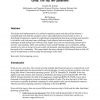2139 search results - page 26 / 428 » Distributed computing and computer security education |
CORR
2006
Springer
13 years 10 months ago
2006
Springer
Due to the convergence of various mobile access technologies like UMTS, WLAN, and WiMax the need for a new supporting infrastructure arises. This infrastructure should be able to ...
SIGCSE
2003
ACM
14 years 3 months ago
2003
ACM
During summer 2002, we ran a workshop module for a group of 28 eighth-grade girls. Our aim was ambitious: to introduce these students, ages 12 and 13, to computer science by focus...
SP
2002
IEEE
13 years 9 months ago
2002
IEEE
The design and implementation of a national computing system and data grid has become a reachable goal from both the computer science and computational science point of view. A di...
SIGCSE
2008
ACM
13 years 10 months ago
2008
ACM
This paper describes CyberCivics, a novel approach to computer science outreach that integrates hands-on computing experiences with the study of contemporary social and political ...
CTRSA
2001
Springer
14 years 2 months ago
2001
Springer
Computationally expensive tasks that can be parallelized are most efficiently completed by distributing the computation among a large number of processors. The growth of the Intern...

